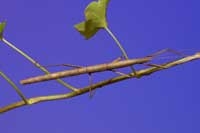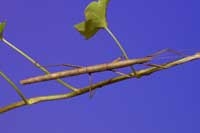Indian Walking Sticks
By Andrea Peck UCCE Master Gardener
What are Indian walking sticks and will they eat my flowers? -Donna J. Los Osos
The Indian walking stick exhibits crypsis, the ability to change color, shape and behavior to blend into their environment. Adult specimens reach up to 4 inches in length. Their long, wingless body is generally brown-colored. When confronted, this amazing creature retracts its legs alongside its body, adding to its appearance as a stick.Originally native to southern India, Indian walking sticks are a familiar attraction in elementary classrooms because they can survive on lettuce, making them an easy pet to care for. Their dramatic appearance and slow swaying motion that mimics a branch in the wind, make these bugs a conversation piece no matter where they perch. These insects became established outside of India as a result of their popularity as pets. The female walking stick is an interesting character that does not require the benefit of male attention to reproduce. Combine that with the ability to lay a significant number of eggs, which often go unnoticed as waste products and you have a recipe for easy breezy reproduction. When kept as pets, it is recommended that cage waste be placed in a tightly sealed bag and thrown away. This should limit the possibility of infestation.
While the Indian walking stick is generally not a major pest, it has become more of a nuisance in recent years. Springtime is typically the time when the most damage occurs. This is because the nymphs hatch and search for small-leafed varieties of ivy and privet. They will also enjoy azalea, bramble, camellia, geranium, hawthorn, hibiscus, jasmine, oak, pyracantha, rose and of course, your veggies. In some locations defoliation of plants and significant damage to valued specimens has occurred.
Control of the Indian walking stick is limited. Pesticides are not recommended. Hand removal, though it can be a challenging game of hide and seek, is the best management strategy.

